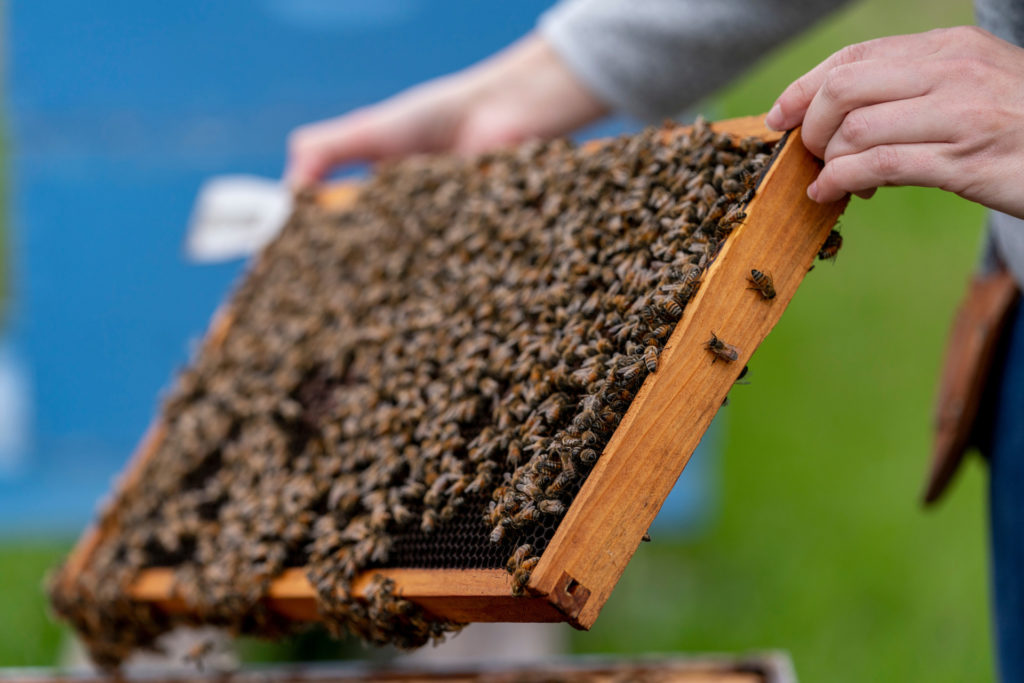Research seeks insights on honeybee diets for healthier hives

Laura McKenzie / Texas A&M AgriLife Marketing and Communications
The old health idiom “you are what you eat” also applies to honeybees.
Texas A&M AgriLife Research scientists are studying how pollen diversity affects the nutritional quality of honeybee diets, including asking foundational questions about how nutrition can sustain healthier colonies.
The four-year study is funded by a $750,000 grant from the U.S. Department of Agriculture National Institute of Food and Agriculture. It will be conducted by co-principal investigators Dr. Juliana Rangel and Dr. Spencer Behmer, both professors in the Department of Entomology within the Texas A&M College of Agriculture and Life Sciences.
The project is exploring honeybee nutrition across multiple landscapes and will provide a multidimensional analysis of pollen as a nutritional resource. It will also examine how bees regulate the collection and consumption of pollen.
The research could provide insights that will guide beekeepers, traditional agricultural methods, and urban/suburban development planning in ways that impact food production, ecosystem health and overall sustainability.
Rangel and Behmer bring together expertise in honeybee biology and insect nutritional physiology, respectively, to investigate the complex relationship between diet and nutrition in honeybees. Their collaboration will analyze how honeybees make decisions when presented with different dietary options.
“Our research focuses on understanding how honeybees choose the best possible combinations of nutrients when given choices between different food resources,” Rangel said. “We are particularly interested in their preferences for pollen, which is their main source of dietary protein, and lipids, plus other essential micronutrients.”
Poor nutrition and landscape changes are two major contributors to losses of over 40% of managed honeybees in the U.S. annually, according to the Bee Informed Partnership. However, the definition of “poor nutrition” for honeybees remains unclear, Behmer said, and the characterization of available nutritional resources across various landscapes is also insufficient.
Behmer said nutritional deficiencies can have negative cascading effects on bees and colonies. Much of the impact of poor nutrition begins in brood food, a milky substance produced by nurse bees to feed bee larvae. Deficiencies of key nutritional components in brood food, especially protein and key lipids, can lead to poor physiological development that can cause undersized adults, deformities and compromise the immune system.
Rangel said preliminary work suggests honeybees tightly regulate their protein and lipid intake, and the fatty acid composition of lipids could play an important role in the bees’ nutritional preferences.
“Honeybees balance their protein-lipid intake, ensuring they do not overconsume either nutrient beyond what is required,” Rangel said. “This balanced approach ultimately contributes to their overall health and well-being.”
The researchers’ overarching hypothesis is that honeybees tightly regulate their intake of multiple nutrients using a two-level process. First, foragers selectively collect pollen based on its nutritional content. Next, nurse bees selectively feed on stored pollen, or bee bread, to balance their nutrient intake, which optimizes their performance and the brood food they produce for larvae.
Rangel and Behmer suspect the nutritional content of pollen varies across landscapes and seasons, but that both foragers and nurse bees can assess the variability and respond appropriately.
The study has three objectives to answer their research questions.
First, researchers will conduct a comprehensive nutrient analysis of pollen, examining the nutritional space available to honeybees across three distinct landscapes – agricultural, urban and rural – while considering seasonal variations.
Second, they plan to perform a multidimensional nutrient analysis of bee bread to gain insights into the role of predigestive pollen processing. This will reveal how nutritional inputs change as pollen is turned into bee bread.
Lastly, the study will characterize the connection between the fatty acid composition of bee bread, nurse bee feeding behavior and physiology, and the overall performance of the colony. The data generated through these objectives will equip beekeepers with valuable insights, enabling them to provide necessary dietary supplementation and improve the health of their colonies.
“Protein has typically been viewed as the key dietary currency, but our feeding experiments with nurse bees suggest that lipids are also really important,” Behmer said. “Lipids, besides providing energy, are important structural components in cellular membranes and as precursors for molecules linked to immunity. We are realizing that honeybee diets are multidimensional and are foundational to their ability to meet challenges and deal with stress.”

